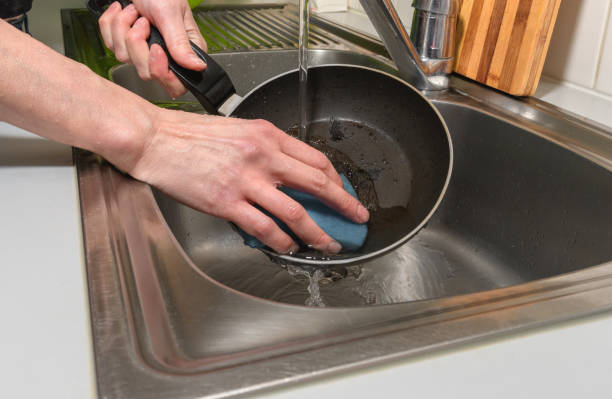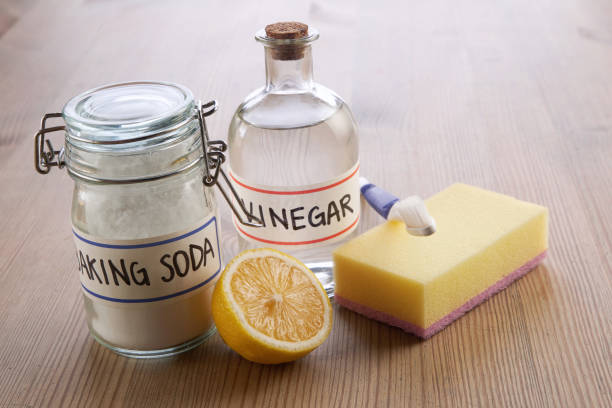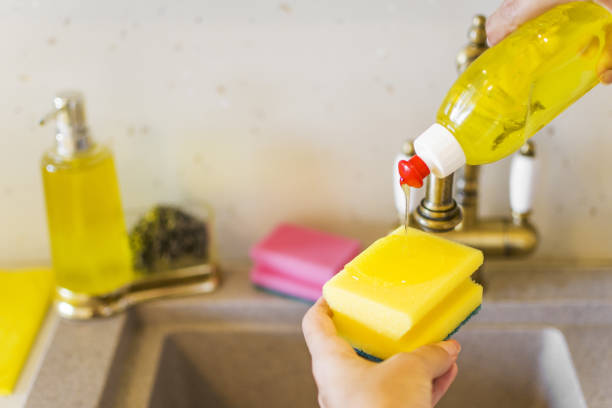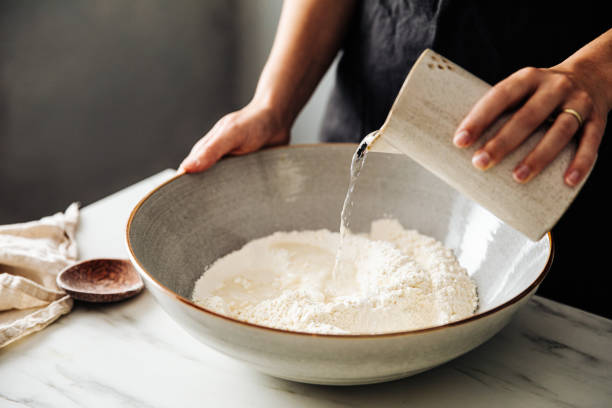What’s your go-to dish when you’re cooking? My cast-iron skillet is indispensable to me. I can honestly say that this pan is the best skillet I own. Having to hand-wash it instead of putting it in the dishwasher means I need good soap to remove the built-up oil and know how to remove grease from dishes in our kitchen.
Before, I was lazy and put my old cast-iron skillet in the dishwasher. It had been well-loved by my family and friends. This was a decision that my husband did not approve of. He is the dish-doing king in our house and is known for being picky, especially about cast-iron skillets. It was a real eye-opener for him when he noticed that, that day, I had been lazy and just put it in the dishwasher. Let me add that.
Forms of Degreasers
Kitchen degreasing can be accomplished using either store-bought or homemade cleaning supplies. So, here’s the deal:

Multi-purpose degreaser: Krud Kutter Degreaser is a staple in the Oliveria product line. She claims that her all-purpose, eco-friendly cleaner can replace 90% of the cleaning products on the market. You already use it to keep the environment safe for people and animals. After five minutes, spray the oily area and wipe it clean. If the area to be cleaned is very oily, you should wait 10 minutes after putting the solution on it.
Create your own degreasers: Use what you have to get by until you can purchase a replacement product. Oliveria recommends the following all-natural degreasers that can be made from items found in most people’s pantries:
- Decant the vinegar water mixture from the bowl into a plastic bottle. The remedy is applied via a quick spray. After ten minutes, wipe it clean. Recently deposited oil or stains will benefit the most from this procedure.
- Long-standing, tenacious grease requires a more potent concoction. Bowl 1 cup vinegar, 3 cups water, 1 cup baking soda, and 1/2 cup dish soap. To use the degreaser, dip a washcloth into the dish and scrub the oily surface. It’s important to follow up by rinsing and wiping the surface again.
- Incredibly, oil can be used to reduce the amount of grease in certain situations. Spray some olive oil (a bargain brand is good; no need to use your expensive EVOO) over the area that needs cleaning. Ten minutes later, wipe everything clean. When you add oil to the situation, the grease becomes less of a challenge to clean off.
Prior to Degreasing
Marilee Nelson, co-founder of Branch Basics and a Texas-based cleaning expert. She recommends cleaning the surface first before removing the grease. Wipe it dry with a new cloth and hot, soapy water. Killing germs by disinfecting frequently used items like counters and cutting boards is essential.
5 Effective Methods to Clean Grease
A grease stain on the floor is a sure sign that you’ve been cooking something fatty, like burgers, chicken, or pizza. A thorough cleaning is on the way, and unless you have the powers of Samantha from “Bewitched,” you can count on it.
Simply using water to wash away the grease won’t work since the molecules of water won’t bind to those of the grease. And sometimes, no amount of manual labor will remove the baked-on grime that accumulates in kitchens. Most grease stains can be removed using a commercial grease cleaner, but what alternatives are there if you don’t have any on hand?
You can combat grease with common household items. These five domestic grease-removing methods will have you relaxed in no time.
1-Vinegar

Spray white vinegar on stubborn oil stains, especially those on the stove and oven, and let it soak for five minutes. Vinegar’s acidity will break down the crusty bits (usually a food-grease mixture) and make them simpler to clean away with a sponge. Vinegar works best when applied to a hot surface.
Thus, clean your oven immediately after use, or bring it to a light simmer first. Vinegar won’t remove oil as alkaline cleaners can, but it will soften the filth so that you can clean it up more easily. To keep your cookware grease-free in the long run, you can use white vinegar.
Explanation of Vinegar’s Effectiveness as a Degreaser
You can use vinegar for just about any cleaning job around the house. Also, it will do a great job. Vinegar’s acetic acid isn’t harsh, so it won’t eat away at your metals. It won’t scratch or hurt your skin, either. However, it is still effective in removing stubborn stains and oil without leaving a film behind. More than that:
- Removes odors and its scent rapidly vanishes.
- It can be used in the presence of both kids and dogs without any worries.
- Pricing is low.
Using Vinegar to Clean Up Oil Splatter on Metal
Combine the Cleaning Agents
Mix hot water and distilled white vinegar 1:1 in a sink or container. If you wish to boost vinegar’s acidic cleaning effectiveness, add one lemon per cup.
Clean Up the Oil
Use the cleaning solution to wet a sponge or soft cloth. Spraying it directly onto the surface works best. To clean off the oil, simply use a damp towel.
Scrub and Air-Dry
Rinse the area and dry the steel with a microfiber towel.
2-Salt Content and Isopropyl Alcohol
Using salt and rubbing alcohol, you may disinfect large, soft materials like chair cushions. Salt mixed with rubbing alcohol can be used to remove discoloration. Cleaning up the leftover salt and greasy solution with a vacuum and a moist cloth should do the trick.
3-Isopropyl Alcohol to Get Rid of Grease
Preparing the Cleaning Agent
Combine isopropyl (rubbing) alcohol with hot water in a sink or other container, using the same ratio as above. You can get rid of the greasy buildup with the help of alcohol’s solvent properties.
Clean Up the Oil
Wipe the grime away with a damp sponge or gentle cloth dipped in the solution.
Fresh and Undampened
Using a clean sponge or towel, wash the area with plain, warm water. Microfiber cloths are ideal for drying metal.
4-Liquid Dish Soap

When grease splatters on the stove, we don’t even bat an eye. The walls and the cabinets. However, what about the clothes we wear? What can you do to rescue that special blouse or tablecloth? If the stain is on a soft surface, try using a small amount of liquid soap and rubbing it in. Soak the sheets for half an hour in soapy water before washing them in cold water.
Dishwashing soaps are among the most effective grease-fighting soaps because of their molecular structure. It’s made to draw oil and grease molecules to themselves so they may be more easily removed. The use of a small amount of dishwashing soap as a pretreatment for greasy smudges on clothing and other linens is quite effective.
Dish Soap as a Grease Remover for Metals
Blend the Cleaner
Dishwashing liquid soap should be diluted in water. So fill a basin or container with a gallon of water and a spoonful of dishwashing soap. Remember that you need to use warm water to get rid of the greasy residue. Grease will harden in cold water, making it more challenging to remove.
Take Care of the Oil and Grease
Using a sponge or cotton towel, wring out the solution. Get rid of the grease by wiping it in a grid pattern or with the metal’s grain. To avoid re-greasing, rinse the sponge often.
Dealing with Overcooked Food
You can use sodium bicarbonate on a damp sponge or towel to remove stubborn grease and charred food. Basically, it’ll be a gentle abrasive.
Do a Final Rinse and Pat Dry
Sponge or wipe the metal down with normal, warm water after it no longer feels greasy. To finish, pat the metal dry with a microfiber towel.
5-Baking Soda and Water
Sodium bicarbonate has several uses as a cleaning product. You may use it to clean almost anything by combining it with water. It is like tarnished copper or countertops with juice and coffee stains. There’s also discolored metal and, of course, stubborn grease.
Due to its alkaline nature, bicarbonate is excellent at breaking down greasy substances. Since it is non-abrasive, the oil is eliminated without risking damage to the cleaned surface. Add 3 teaspoons of sodium bicarbonate to 1 cup of water and stir. You can easily get rid of light oil stains on your stove, countertops, and other hard surfaces by scrubbing them with a sponge. It has been soaked in the solution.
Using Baking Soda to Remove Stains and Grease Marks
- Create a cleaning solution by combining the bicarbonate, lemon juice, and warm water.
- After filling a spray bottle, spray the kitchen cabinets.
- So that the bicarbonate can take effect, let it sit for a few minutes (ideally three).
- Scrub the grime away with the sponge. Sponge-washing should be done as often as needed.
- After drying the cabinets with a clean cloth, you can admire your work.

Flour
If you spill grease while cooking, it’s easy to clean up before it gets worse. Flour can be sprinkled over the mess as a quick fix. For a quicker clean-up, wait a few minutes for the flour to absorb the fat. When the grease is wet, this method succeeds. If so, move on to Option Two.
Here’s How to Remove Grease from Dishes on Kitchen Surfaces
If you’re hungry at any hour of the day, fried food is one of the best things to order. In case you share our love of fried foods. You’ll want to know the tricks used by the pros to prevent oil buildup. Let’s look at how to remove grease from dishes in kitchen appliances here:
Stovetop
The components of the stove that can be removed should be taken out first. Fill a big bowl with heated water and dishwashing soap, or stop up your kitchen sink. Place the components in soapy water while you clean the stove to get rid of food stains and oil that have baked on them.
Stainless Steel Appliances
Despite appearances, oil can remove oil stains. With a clean towel or cloth and a dab of olive oil, wipe the metal in the same way as the grain. Then, wipe the excess oil away using a soft cloth.
Oven
Before you try to clean the oven all the way, use a nonabrasive scraper to get rid of the baked-on grease spots. Use a moist paper towel to wipe clean the oven interior to eliminate any lingering residue. Then apply the homemade degreaser or enzyme cleanser. Give it 15 minutes before cleaning it down.
A baking soda-water paste can be used to coat the oven. Use a soft-bristled brush to apply the paste liberally throughout the interior, and then leave it alone for the night. According to Merry Maids’ resident cleaning guru, Debra Johnson:
“If you’re in a hurry, you can let the sodium bicarbonate rest in a heated oven for 10–20 minutes. The baking soda will need to be wiped away and removed before you can use the area again. “Apply as much heat as you can handle with a damp cloth.”
Microwave
Grease stains in the microwave are a blast to clean and can really improve the aroma of your kitchen. Mix the juice of one lemon with three to four glasses of hot water from the faucet in a glass basin. In the microwave, water can be brought to a boil in 3 to 5 minutes.
Steam softens microwave oil and debris, so close the microwave door for a few minutes. grime. Take out your microwave’s glass bowl and give it a good cleaning. White vinegar or an all-purpose cleaner can be used to spray the inside of the microwave. Let it air dry once you’ve wiped it down.
Backsplash
As a final step, install the backsplash. Natural treatments are the greatest option for cleaning a backsplash, says Debra Johnson. She recommends placing one lemon juice into a squeeze bottle. The ease with which this removes oil will astound you. After waiting a few minutes, remove it by washing the area with water and drying it with a clean cloth.
Finally, remember that a severe grease buildup can be avoided by simply washing down kitchen surfaces as soon as grease streaks are spotted. For every fried, expert recommend splatter shields and a lid.
When Should You Clean Your Metal?
To avoid grease buildup, clear the cooktop and other splatters immediately. Kitchen appliances like the fridge, microwave, dishwasher, and other small equipment should be cleaned at least once a week. Maintaining a clean oven and dishwasher will keep them free of grease buildup.
Frequently Asked Questions
Q: What can be used to remove greasy substances?
The grease can be easily removed by using white vinegar. Soak a sponge or rag in vinegar and apply it to the oily spot. Then, clean it up by wiping it. Use it on glass, metal, or any other non-porous surface, and the grease should be gone in no time.
Q: How do I get grease off the walls of my kitchen?
You can apply a paste made of sodium bicarbonate and warm water to the wall. Wait one minute, then use a moist towel to remove the stain.
Q: How can I get the grime off of my windows?
Many different approaches exist for making this happen. Vinegar or Dawn can clean excessively dirty windows.
Q: Can anyone remove old grease?
Sodium bicarbonate, kosher salt, and dish soap can remove crusted fat. You could use a somewhat rough sponge instead of a rag to get rid of stubborn dirt.
Q: What can be done to remove old, crusty grease?
Prepare a solution of one cup of water and three teaspoons of sodium bicarbonate. Get to cleaning by saturating a sponge in the solution.
Final Words
It’s a major pain to deal with burnt-on grease. It’s not usually as simple as just applying one cleaning product and calling it good, but occasionally we get lucky. When I clean, I normally begin in a methodical manner. If that fails, resort to throwing everything I own at the problem.
Because what removes one stain often does not remove another, formulating a truly all-purpose cleaner is quite challenging. The best defense against these cleaners is a good offense. Aside from that, the best defense is knowledge.

